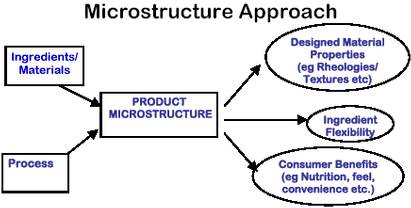Professor Norton left his role as Chief Scientist at Unilever to take a Chair as Professor of Soft Solid Microstructural Engineering in the Department of Chemical Engineering. Professor Norton's doctorate was in the Physical Chemistry of polysaccharide conformational transitions were he focused on fast reaction kinetics and thermodynamics.
Once he joined industry, he moved into the area of colloids and interfaces and developed a microstructure approach. This approach is were the material properties are designed by choosing the ingredients and the way they physically interact and then designing the process to physically structure and trap the microstructure in the desired state, see figure.

The material thus produced determines the material properties, can allow ingredient flexibility in terms of alternatives and replacement, and impact on consumer response ranging from what they are eating, their nutrition and health to what they use to clean their homes or groom themselves.
Professor Norton used this approach to design foods and home and personal care products for Unilever, resulting in a large number of new inventions (he is an inventor on more than 60 granted patents) leading to many new and innovative products, which are still sold today. In his new role at the University Professor Norton will continue this work and extend to a wider range of soft solids. Soft solids are used extensively in: Foods, Personal Care Products, Cosmetics, Paints, Pharmaceuticals, Home Care / Hard Surface cleaning and Laundry.
Professor Norton has authored more than 100 original refereed papers on the science and engineering of biopolymers, fat physical chemistry, kinetics, emulsions, rheology and material science and is an inventor on more than 60 granted patents covering ingredients, spreads, dressings, sauces, skin creams, shampoos and ice-cream.
Current research interests:
- Emulsions/Emulsification
- Interfacial design - chemical composition, material properties and rheology
- Biopolymer solutions and gels - single systems and mixtures, processing control of structures
- Physical chemical aspects of nutrition and health - in particular how food microstructure can be used to impact on food consumption and the dynamics of macronutrient release
- Encapsulation and release - targeted delivery
- Colloids at surfaces and bio-surfaces
- Crystallisation / Control of crystal morphology and networks - by the chemistry and the processes
- Material properties of soft solids (including rheology and fracture and flow)
- In use properties - oral processing, skin applications, cooking, surface behaviour etc